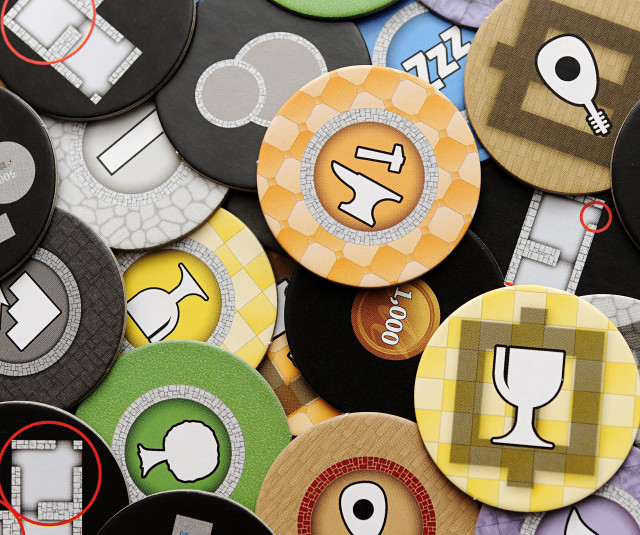Castles of Mad King Ludwig has an auction element to it and hidden and shared goals, but it’s really all about architectural feng shui. You’re getting the blueprints to a palace one room at a time which isn’t the most efficient way to plan a castle, but hey, it’s not the Castles of Rational King Ludwig.
Before the game, players are dealt three secret goal cards. They’ll choose two to keep. These compliment three public goal cards that are shared by all the players. Goals will help inform how to best construct your castle to maximize end game scoring.
There are ten different sizes of rooms and eight different types. They range in size from 100 square feet all the way up to 600 and they’re classified as Activity, Outdoor, Food, Utility, Corridor, Living, Sleep and (what castle would be complete without:) Downstairs.
At the start of the game the contract board gets seeded. Flipping from the top of the room card deck gives you the size of the rooms you’re going to draw for the next round. Each building size has potential to be three different types. For example if you draw a 400 square foot room you know that it is either going to be a Living, Outdoor or Sleep room; 100 square foot rooms are going to be Utility, Food or Living Rooms.

A Master Builder is chosen and they will decide on the value of the rooms for the round by arranging them on the contract board. Players will have to decide if they want to pay what the Master Builder is requesting for the rooms. The Master Builder is hoping to get the most money out of the other players with a high value of $15,000. Charge too much for a room and no one might pay that price, charge too little and you could miss the opportunity to make big bucks. The value the Master Builder places on the different rooms is really important. Some rooms will be worth more points when added to the board, but harder to complete. Other rooms may have potential to yield big end game scoring depending on the private and shared goals that are out there. Setting up the Contract board is pretty important and does have the potential to cause a bit of analysis paralysis. Checking out your opponents castles and gauging what the market rate should be for each room takes a few moments. However, it doesn’t feel like too much down time as players can make decisions based on how much they’re able to spend or what they think will still be on the board when their turn comes around.
Each player starts with a humble Foyer that they will add to throughout the game. On a turn they will choose one of the available rooms from the Contract Board, paying the Master Builder the requested price and adding it to their castle. If none of the rooms are appealing or the prices are too steep, you have options on your turn. You can buy a Hallway or Stairs for only $3000. You’ll need stairs to get down to the basement and use Downstairs rooms. You can also just take $5000 from the bank. It’s not the most exciting move, but sometimes you just gotta do it.
Rooms can be added by aligning one or more of their doorways with existing doorways in your castle. Each doorway to a room must meet another doorway and not run into a wall. The one exception to that rule is Hallways which are made completely of potential doorways or nooks. When the room is placed you’ll score points for the room itself and possibly gain or lose points depending on adjacent rooms. For example the Nap Room (a Sleep room) is worth two points on its own and two more points if it’s placed next to a Living room. On the other hand, performers are a testy group and prefer not to be disturbed. Activity rooms, like the Theatre (worth 6 points when placed) are going to lose you points when placed beside Utility, Corridor, Living or Sleep rooms.
A room is considered incomplete if there are still open doorways coming off of it. Once each door is connected in some way the room is complete and you can take a bonus depending on the room type. Closing an Activity will get you five points, Outdoor will earn $10,000, Food gives you and extra turn, Utility lets you draw more bonus cards, Living allows you to re-score the room, Corridor gives you a free Hallway or Stairs to place, Sleep lets you seed some rooms for the next round and Downstairs rooms unlock one of the other seven bonuses.
This game is a great deal of fun. Seeing how your castle comes together and finding point-scoring synergies is amazingly satisfying. Don’t stop to ask why you’d have a Dirt Room next to a Lilac Closet…or even what a Dirt Room is…or a Lilac Closet for that matter!

The overhead view of each room is pretty cool. The art is simple, but contains enough detail that you can imagine the hallways, courtyards and living spaces populated with tiny nobles; the kitchens and stables being worked by the staff of the castle.
It’s got some similarities to Ted Alspach’s recent hit Suburbia and that makes a lot of sense. Alspach designed Castles as well. I think he’s going to have another hit on his hands with Castles of Mad King Ludwig. It’s well worth checking out!
Comments
No comments yet! Be the first!